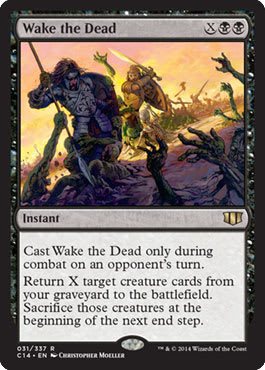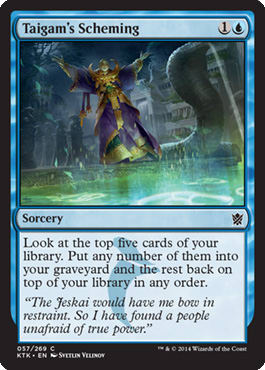In this experiment, we address the question of what happens when a Devil, a Drake, and a Chronarch walk into a bar.
I sometimes look through recent Magic releases in search for new combo fodder. My most recent search put me on the tail of a card I couldn’t believe I’d missed when it was previewed, when it was released, or even when I’d subsequently run across it on Gatherer.
Wake the Dead’s purpose seems obvious: It’s an effect for creating surprise blockers out of our graveyard. The creatures are only good for blocking, though, as they return to the grave at the end of the turn. We can even create as many blockers as we like, provided we can pay an amount for X that’s equal to the number of creatures we desire.
The effect is decidedly fair, as we only have the creatures during one opponent’s turn, so we can’t even attack with them.
The fallacy with this line of thinking rests in the various powerful creature abilities that exist, especially as enters-the-battlefield triggers. For example, if one of the “blockers” we returned was Archaeomancer, we can return Wake the Dead to our hand immediately after resolving it. And if one of our blockers was Peregrine Drake, we can untap the lands we tapped to cast Wake the Dead. That leaves us just where we started, though we’ve gained a 1/2 and a 2/3. We can chump-block with those creatures and be ready to do so again on our next opponent’s turn.
Of course, we can’t win the game by blocking. With the small addition of an Altar of Dementia, we go from blocking two creatures for as many turns as we want to milling out all of our opponents during one player’s beginning-of-combat step. Oh, and we can also generate infinite mana.
When we return the Archaeomancer and the Peregrine Drake, we’ll get to untap five lands, but we only spent ![]()
![]()
![]() , so we can net 1 mana. And if we sacrifice the two creatures to the Altar, they’ll be back in the graveyard for us to Wake the Dead again. We can mill out all our opponents without ever moving to the opponent’s declare-attackers step.
, so we can net 1 mana. And if we sacrifice the two creatures to the Altar, they’ll be back in the graveyard for us to Wake the Dead again. We can mill out all our opponents without ever moving to the opponent’s declare-attackers step.
Buried Alive
Wake the Dead’s superpower is to return creature cards from our graveyard, so while Altar of Dementia would be a fine inclusion here, I wanted to focus on creatures if I could so that we could go from having nothing on the battlefield to winning the game with nothing but a Wake the Dead.
That meant I needed to find a creature that could use the creatures entering the battlefield as a way to kill my opponents, and I also needed a way to put the creatures back into my graveyard. Sure, they’d go there at the end of the turn anyway, but I want to win all at once as soon as I go in on my black instant.
A creature with a Pandemonium-like ability would work, as would a creature with a sacrifice power that generated some kind of game-winning effect. For example, something that said, “Sacrifice a creature: This creature deals 1 damage to target player,” would work. Unfortunately for us, most creatures that sacrifice creatures for effect also require some kind of mana payment—either that or they do something innocuous, such as regenerate themselves.
Phyrexian Plaguelord can kill our own creatures and our opponents’, so that can be useful. Viscera Seer is cheap, but its ability to scry isn’t actually going to win us the game (though I suppose we could scry up an X spell given that we may be able to generate infinite mana with a sacrifice outlet). If we are generating mana, Gutless Ghoul can gain us as much life as we like.
There are a lot of artifact options here, but Wake the Dead can’t return those, and our Buried Alive can’t fetch them.
Oh wait; did I say something about Pandemonium? To synergize with the undying keyword from Innistrad block, Flayer of the Hatebound has a Pandemonium-like ability that only works with creatures entering the battlefield from the graveyard. Incidentally, that is exactly what creatures woken from the dead will be doing. And thus, we have our third creature for Buried Alive.
Sacrifice a Creature
Unfortunately, an Archaeomancer effect, a Peregrine Drake effect, and a Flayer of the Hatebound do not a win condition make. If we replace Archaeomancer with Izzet Chronarch, it can kill itself with the Hatebound trigger. Peregrine Drake can kill the Flayer, and the Flayer can kill the Drake. The Flayer will return with undying, and it can kill itself again. After all that, we’ll have our mana available and the Wake the Dead back in our hand, so we can do it all again.
The problem is that we didn’t actually do anything to an opponent during all of that. (If there were a 3/2 with an Archaeomancer ability, the Flayer could sit in play while we cast Wake the Dead repeatedly for ![]()
![]()
![]() and the Drake and 3/2 killed each other, thus making us 1 mana every time we untapped our five lands.) We could have a second Flayer of the Hatebound to double up on the triggers and actually make progress, but otherwise, we’ll need to actually include one of those sacrifice outlets.
and the Drake and 3/2 killed each other, thus making us 1 mana every time we untapped our five lands.) We could have a second Flayer of the Hatebound to double up on the triggers and actually make progress, but otherwise, we’ll need to actually include one of those sacrifice outlets.
I’ve included Phyrexian Plaguelord as a one-of in order to mitigate our opponents’ boards. But it’s a 5-drop, and ideally, turn five is when we’ll be winning (albeit on an opponent’s turn, so it could technically be turn six if we’re last in turn order).
Viscera Seer, on the other hand, is something we can have cast already by then, and it may even have made itself useful in helping us find our Wake the Dead, Buried Alive, or whatever else.
Corpse Connoisseur is a popular card among my graveyard-and-creature-based decks, though it also costs 5. Still, it’s useful for helping to set up our combo, whereas the Plaguelord is only at its best here while we’re in the middle of it.
Grixis Remnants
One Great Whale can function as a Peregrine Drake. In a way, Great Whale seems strictly better since we don’t plan to pay for our Peregrine Drake anyway. However, we may sometimes just need to cast stuff, and the 7 mana of the Whale is rarely accessible, while the additional mana it can generate for us is superfluous.
Mystical Teachings is the tutor option I decided on to find Wake the Dead. The Teachings doesn’t find anything else for us, so you may decide to try the likes of Cunning Wish, Diabolic Tutor, or Mystical Tutor.
Taigam's Scheming is not a particularly strong card, but I decided to give it a shot here. It puts us down a card, which is not a place any deck really wants to be. But it can put multiple cards into our graveyard, potentially setting us up for an earlier Wake the Dead win than might have otherwise been possible. It only costs 2 mana, so if we find a Buried Alive with the scheming, we can stay on curve (Viscera Seer, Taigam's Scheming, Buried Alive, Mystical Teachings, Wake the Dead). Of course, a supercharged Taigam's Scheming is all we actually need (dump Peregrine Drake, Izzet Chronarch, Phyrexian Plaguelord, and Flayer of the Hatebound, and keep Wake the Dead on top).
Desolate Lighthouse doesn’t make colored mana, but it lets us dump creatures that we want in our graveyard all while helping us find the spells we want to be casting.
Peregrine Dead ? Casual | Andrew Wilson
- Creatures (20)
- 1 Great Whale
- 1 Phyrexian Plaguelord
- 2 Flayer of the Hatebound
- 4 Corpse Connoisseur
- 4 Izzet Chronarch
- 4 Peregrine Drake
- 4 Viscera Seer
- Spells (16)
- 4 Mystical Teachings
- 4 Wake the Dead
- 4 Buried Alive
- 4 Taigam's Scheming
- Lands (24)
- 2 Island
- 5 Swamp
- 2 Blood Crypt
- 2 Desolate Lighthouse
- 4 Tainted Isle
- 4 Tainted Peak
- 4 Watery Grave
- 1 Urborg, Tomb of Yawgmoth
One of the questions of the deck is what is the minimum it requires before it can start going off. Absolute necessities include Peregrine Drake (or Great Whale, or Palinchron if you prefer), Izzet Chronarch (or Warden of the Eye, Archaeomancer, etc.), Flayer of the Hatebound, and Viscera Seer (or Phyrexian Plaguelord, Dimir House Guard, etc.).
However, they don’t all have to come out on the same Wake the Dead, and they don’t all have to be in our graveyard when we start going off. We only have to pay
In this first example, with 5 mana, we cast Wake the Dead targeting Peregrine Drake, Izzet Chronarch, and Flayer of the Hatebound. Using the Flayer triggers, Izzet Chronarch kills itself (thus its advantage over Archaeomancer), Peregrine Drake kills Flayer of the Hatebound, and the Flayer kills the Drake. The Flayer returns with undying, and we deal the damage to an opponent. We have 5 mana and Wake the Dead back, so we cast it again, this time targeting the Drake, the Chronarch, and Corpse Connoisseur (or a sac outlet if we already have one in our graveyard). The Connoisseur searches up the sac outlet, and its Flayer trigger kills the Drake. The Chronarch kills itself again, and the Drake deals 2 to an opponent. Again, we have our mana and our Wake the Dead back, so we cast it again, finally targeting the sac outlet, the Drake, and the Chronarch. From here, we can use Flayer triggers on our opponents, and we can use the sac outlet to return our Drake and Chronarch to the graveyard (possibly netting some sac value along the way). From there, we win.
In the second example, we have a sac outlet available but not a Flayer. We Wake the Dead the Drake, Chronarch, and sac outlet. We sac the Drake and Chronarch and cast Wake the Dead again, this time returning them with the Connoisseur, which finds us the Flayer. We sac the Drake and Chronarch, and we cast Wake the Dead on them and the Flayer. From there, we repeat ad nauseam.
The Peregrine Drake (or Great Whale) and Izzet Chronarch are absolute essentials for going off, as is at least one way to kill them off for repeats (Flayer or a sac outlet), but we can get started with only three of the four cards we need, especially if Corpse Connoisseur is there to stand in for the fourth piece.
If you love infinitely returning things from the dead, if you love untapping lands, or if you just want to use Mystical Teachings as inefficiently as possible, give this deck a try.
Andrew Wilson
fissionessence at hotmail dot com



























